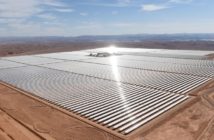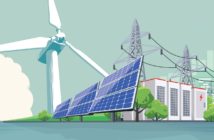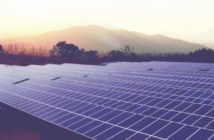Andrew
As longstanding ruling regimes shake and fall around them, Moroccans to date have been able to steer a moderate, comparatively peaceful course of socio-political change that’s seen the establishment of a new constitution based on modern pluralist democratic principles tolerant of social, political, and religious diversity. Encouragingly, with regard to energy policy, that’s included moving forward with a progressive, proactive national renewable energy and energy efficiency strategy that includes renewable energy sources meeting 42% of electricity demand by 2020.
The ramifications of working to reach that goal are deep and far-reaching. In doing so, Morocco’s government believes it can steer a new course of socio-economic development that will yield big, long-lasting dividends not only in terms of energy security and self-reliance, but in terms of social equity, economic opportunity, and environmental sustainability.
In a July 12 interview, the director of Morocco’s new renewable energy agency, Agence Nationale pour le Developpement des Energies Renouvelables et de l’Efficacite Energetique (ADEREE), Saïd Mouline, laid out in more detail the aims, underpinnings, and means by which Morocco is working to realize its renewable energy and energy efficiency goals. Taken at face value, they appear ambitious and impressive, yet also practicable.
Renewable Energy: Morocco’s Solution to a Mix of Interrelated Problems
At present, some 95% of Morocco’s total energy demand is met by imports, primarily of oil, coal and natural gas, Mouline told CleanTechnica. That’s been a big drain on the country’s balance of trade and foreign exchange reserves, which has only surged higher with the run-up in petroleum prices that began around the mid-2000s. The social, political, and environmental ramifications associated with its dependence on fossil fuel imports compound the problems associated with fossil fuel dependence, he noted.
On the other hand, the cost of electricity from renewables — wind and solar, in particular — is already at or very near parity with grid power from fossil fuel power plants. Newly installed wind power is already cost-competitive with conventional electricity from Morocco’s grid, and new solar power is nearly there, as costs have declined sharply in the past few years, Mouline pointed out, and that’s just looking at renewables from a purely hard and narrow dollars-and-cents perspective.
The cost of electricity for individual consumers in Morocco is based on a sliding scale, Mouline explained: 7 US cents/kWh for the first 100kWh moving up to 16-17 cents per kWh if you consume more than 400kWh per month, “so the heavy users pay proportionally higher.” Many Moroccan homes, he added, consume very little electricity as compared to their European counterparts (and much less than US residents) – less than 400kWh per month.
There’s another sliding scale of electricity billing for industry. Rather than being linked to consumption, it’s linked to time-of-day power consumption, he continued. For commercial/industrial consumers, electricity rates range from 7 cents to 10 cents per kWh.
Morocco believes developing its considerable renewable energy resources and enhancing energy efficiency can go a long way towards addressing all these interrelated issues, Mouline said, even to the extent, in terms of the energy sector, of transforming the nation from a fossil fuel importer to a “green” energy exporter to Europe.
Morocco’s renewable energy and green economy ambitions don’t stop there, however. In addition to investing in solar, wind, and other renewable energy projects and infrastructure on both the small and large scale, Morocco is marshaling its own resources while working internationally with other governments, development organizations, and foreign companies in establishing not only the infrastructure, but also the critical legal framework and educational and vocational training capacity, to build a “green” energy economic sector that it projects will create some 50,000 new jobs by 2020.
The environmental benefits aren’t being overlooked, either, Mouline continued, noting that Morocco has a national CO2 emissions monitoring authority that enables renewable energy project owners to qualify for UN Kyoto Protocol Clean Development Mechanism (CDM) carbon offset credits. The owner of Morocco’s first wind power project, a 60-MW wind farm in south-central Morocco, was able to sell CDM credits at $13 per metric ton for every metric ton avoided. More impressively, all 300-MW of wind power capacity up and running in Morocco today has qualified for CDM carbon offset credits.
Mouline acknowledged the challenges and magnitude of change required to realize the country’s renewable energy/energy efficiency strategy goals.
“It’s a drastic change. We managed to convince the government and others to enact the renewable energy/energy efficiency policy by convincing them it’s time to have a new strategy because of our resources and our needs. It’s not only a matter of energy capacity and production, but a matter of energy independence, which is very important today, as well as protecting the environment and stimulating economic and jobs growth.”
Commitment at the Highest Level
Morocco’s government, at the highest level, is committed to following through on the broad-based initiatives related to its renewable energy / energy efficiency strategy, which was initiated in 2009 in a letter from King Mohammed VI prioritizing renewable energy and energy efficiency in the government’s energy policy while setting goals for 2020.
“There’s a strong, proactive commitment at the highest level of the state,” Mouline told CleanTechnica, noting that Morocco’s involvement with renewable energy dates back to 1982 and the second OPEC “oil shock” with the establishment of renewable energy development center.
With support from USAID, Morocco’s renewable energy sector set out to use solar panels for rural electrification and solar-powered water pumps for agriculture, efforts that ADEREE and other government agencies are expanding upon today. Renewable energy initiatives broadened out in the ’90s, Mouline continued, when Morocco started looking into developing its wind energy resources.
Working with international development agencies such as the World Bank Group, Morocco’s government is planting the seeds that it anticipates will develop into a healthy, vital, and fully fledged renewable energy and energy efficiency economic sector.
Attracting technical expertise and resources from private sector companies, both domestic and foreign, is a central piece that’s required to make this happen, Mouline said. “We have different equipment (automotive, aeronautics, …) being manufactured here in Morocco, now we’re looking for renewables. We have some incentive zones for investment in this field.”
Morocco: Renewables Today
Renewables today account for only 5% of Morocco’s energy supply, which provides a perspective that makes it more clear just how ambitious the country’s renewable energy / energy efficiency plans are, as well as the profound changes that will result as it works to achieve them.
Hydro power and wind power account for nearly all Morocco’s online renewable energy capacity at present, but that’s changing, and quickly, Mouline pointed out.
“Today, we have almost 2 GW of renewable energy online — 1.7 GW of hydro and 300 MW of wind. We plan to add 4 GW in the next eight years in order to reach 42% of electricity capacity in 2020 from renewables given a total grid demand of 13-14 GW.”
Masen, the Moroccan solar energy agency, is in the final stages of selecting the lead developer of the 500-MW Ouarzazate Concentrating Solar Power (CSP) farm, a billion-dollar project that the World Bank Group is helping bankroll to the tune of $300 million. The field of bidders has been narrowed down from 19 to three, with the award expected to be announced shortly, Mouline said.
Ouarzazate’s just the beginning for utility-scale solar power in Morocco. Masen have plans to develop five utility-scale solar power fields, a total of 2GW of new capacity. Request for proposals to design, build and maintain them will be issued, with qualified, successful bidders able to negotiate 25-30-year power purchase agreements with OED, Morocco’s national electric utility, Mousine explained.
At the same time, ADEREE is expanding plans to develop markets and local use of distributed solar PV and solar thermal systems in rural and urban areas across the country. Some 60,000 Moroccan households have solar power systems up and running at present, according to Mouline, though they are in remote areas, where average power consumption is only 100-Wp.
Self-Reliance and Green Jobs
The potential for local job creation and energy self-reliance are particularly high for small-scale, distributed solar energy, so ADEREE’s focusing on starting solar PV housing programs.
“We’re initially focusing not only on big projects, but also smaller ones. We started using solar PV some years ago, starting with solar houses in rural areas, then because of technological advances and price reductions, we’re now looking at grid connected projects,” Mouline commented.
“Small projects create a lot of jobs. Anyone with up to 20-kW solar power system can do whatever he or she wants. Up from that, you have to declare it to the Ministry of Energy, a matter of informing the government so they can gather data. For 2MW solar power systems and up, you need authorization and you will need a grid connection,” he explained.
Also, he added, “we are now monitoring the markets for and use of solar-powered pumps,” particularly associated with agriculture, but also with telecoms. “We’re trying to implement a new program for solar pumping,” given the rapidly narrowing gap in cost between grid and solar power.
Ongoing development of its wind energy resources and capacity continues to be a focal point for Morocco’s energy agencies as well. Mouline pointed out that the government is now helping launch a new national wind energy program worth more than $1 billion that aims to see the construction and launch of an 850-MW wind power equipment factory that will manufacture turbine blades, nacelles, and spare parts. Sixteen bid proposals have been received, with the national utility having begun the process of evaluating them.
The Possibility of Renewable Energy Exports to Europe
Also vital to the renewable energy / energy efficiency strategy’s success and job creation, Morocco is investing in building out a modern electricity grid and distribution lines. These are key to the government’s plans to export green energy to Europe.
“We’re thinking to develop all power into the grid, private or public, but in future to have some small power for own production,” Mouline noted. “We’re studying the use of low-tension-line input into grid, for such things as connection home solar PV systems to the grid.”
“We have the 400kV, then the 225 kV, the 150kV, and the 60kV high-voltage grid for transport and the MidTension and Low tension grid for Distribution, which will be used in cities.” Industrial zones and centers, along with utility-scale solar and wind power farms have high-tension grid connections.
In addition, ADEREE and the Moroccan government are allowing the use of an HVDC (High-Voltage Direct Current) transmission grid that will enable Morocco to export renewable electricity from utility-scale solar and wind power plants to Europe. The focus now is on expanding and modernizing its electrical grid. Morocco already has a 1.4GW-capacity grid line into Europe via Spain in place, Mouline pointed out, adding that Morocco is working out the legal details with its European counterparts.
“We have a grid capacity connection of 1.4 GW today, and we’re going to add 700 MW to reach 2.1 GW,” Mouline said. “Instead of importing energy, because of all this green energy potential that will help European countries to reach their CO2 emission objectives, we’ll start exporting green energy to Europe.”









